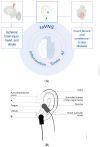Transcutaneous Non-Invasive Vagus Nerve Stimulation: Changing the Paradigm for Stroke and Atrial Fibrillation Therapies?
- PMID: 39766218
- PMCID: PMC11673676
- DOI: 10.3390/biom14121511
Transcutaneous Non-Invasive Vagus Nerve Stimulation: Changing the Paradigm for Stroke and Atrial Fibrillation Therapies?
Abstract
A new therapeutic approach, known as neuromodulation therapy-which encompasses a variety of interventional techniques meant to alter the nervous system in order to achieve therapeutic effects-has emerged in recent years as a result of advancements in neuroscience. Currently used methods for neuromodulation include direct and indirect approaches, as well as invasive and non-invasive interventions. For instance, the two primary methods of stimulating the vagus nerve (VN) are invasive VN stimulation (iVNS) and transcutaneous VN stimulation (tVNS). Since the latter is non-invasive, basic, clinical, and translational studies have focused on transcutaneous auricular VN stimulation (taVNS), the primary tVNS therapy, because of its advantages over iVNS, including ease of use, greater accessibility, and a lower side effect profile. taVNS is currently used as a novel neuromodulatory application to treat cardiovascular, mental, and autoimmune diseases. Future applications of this non-invasive neuromodulation technology to conditions like atrial fibrillation (AF) or ischemic stroke are highly likely due to its advancement.
Keywords: atrial fibrillation; cardiovascular diseases (CVD); inflammation; neuroplasticity; stroke; taVNS; vagus nerve.
Conflict of interest statement
The author declares no conflicts of interest.
Figures




Similar articles
-
Transcutaneous auricular vagus nerve stimulation would be an alternative to implantable cervical vagus nerve stimulation in some situation.J Tradit Chin Med. 2023 Jun;43(3):627-630. doi: 10.19852/j.cnki.jtcm.20230308.002. J Tradit Chin Med. 2023. PMID: 37147767 Free PMC article.
-
Motor Activated Auricular Vagus Nerve Stimulation as a Potential Neuromodulation Approach for Post-Stroke Motor Rehabilitation: A Pilot Study.Neurorehabil Neural Repair. 2023 Jun;37(6):374-383. doi: 10.1177/15459683231173357. Epub 2023 May 20. Neurorehabil Neural Repair. 2023. PMID: 37209010 Free PMC article. Clinical Trial.
-
Transcutaneous vagus nerve stimulation (tVNS) in stroke: the evidence, challenges and future directions.Auton Neurosci. 2022 Jan;237:102909. doi: 10.1016/j.autneu.2021.102909. Epub 2021 Nov 14. Auton Neurosci. 2022. PMID: 34861612 Review.
-
Effects of transcutaneous auricular vagus nerve stimulation paired with tones on electrophysiological markers of auditory perception.Brain Stimul. 2023 Jul-Aug;16(4):982-989. doi: 10.1016/j.brs.2023.06.006. Epub 2023 Jun 17. Brain Stimul. 2023. PMID: 37336282
-
Transcutaneous auricular vagus nerve stimulation as a novel therapy connecting the central and peripheral systems: a review.Int J Surg. 2024 Aug 1;110(8):4993-5006. doi: 10.1097/JS9.0000000000001592. Int J Surg. 2024. PMID: 38729100 Free PMC article. Review.
References
-
- González-González M.A., Conde S.V., Latorre R., Thébault S.C., Pratelli M., Spitzer N.C., Verkhratsky A., Tremblay M., Akcora C.G., Hernández-Reynoso A.G., et al. Bioelectronic Medicine: A multidisciplinary roadmap from biophysics to precision therapies. Front. Integr. Neurosci. 2024;18:1321872. doi: 10.3389/fnint.2024.1321872. - DOI - PMC - PubMed
-
- Macdonald A.J.R. A Brief Review of the History of Electrotherapy and Its Union with Acupuncture. Acupunct. Med. 1993;11:66–75. doi: 10.1136/aim.11.2.66. - DOI
-
- Salvador E., Kessler A.F., Domröse D., Hörmann J., Schaeffer C., Giniunaite A., Burek M., Tempel-Brami C., Voloshin T., Volodin A., et al. Tumor Treating Fields (TTFields) Reversibly Permeabilize the Blood–Brain Barrier In Vitro and In Vivo. Biomolecules. 2022;12:1348. doi: 10.3390/biom12101348. - DOI - PMC - PubMed
-
- Foley J.O., DuBois F.S. Quantitative studies of the vagus nerve in the cat. I. The ratio of sensory to motor fibers. J. Comp. Neurol. 1937;67:49–67. doi: 10.1002/cne.900670104. - DOI
Publication types
MeSH terms
Grants and funding
LinkOut - more resources
Full Text Sources
Medical

